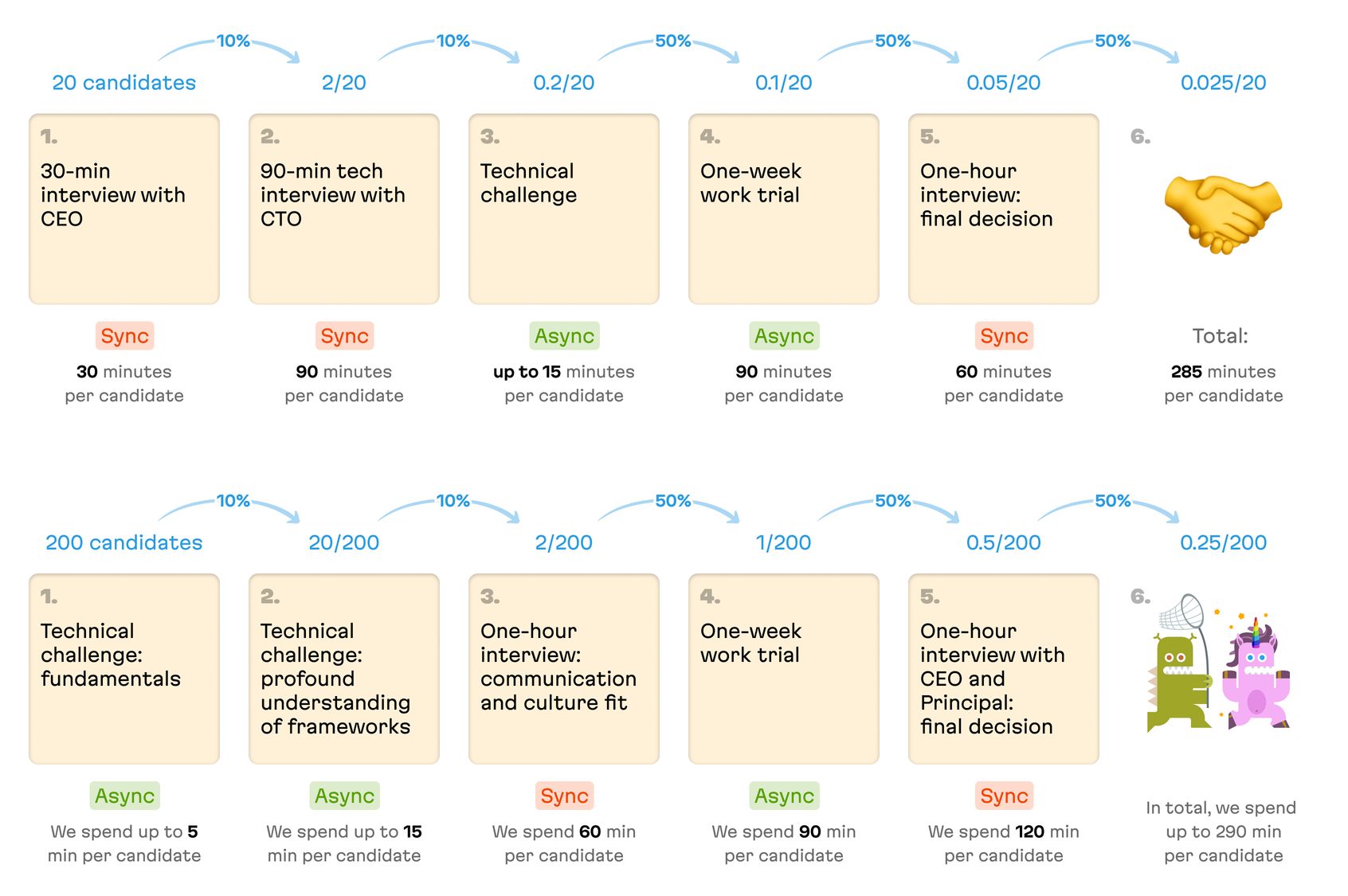Hire better, 10X faster: how we screen 50 engineers weekly with no HR

Here’s a counterintuitive truth about hiring frontend engineers: starting with a CEO chat or diving straight into technical interviews isn’t just inefficient—it might cost you the best candidates. At Evil Martians, we process about 50 frontend candidates weekly (without a dedicated HR team) and still manage to retain the best talent. How? By turning conventional hiring wisdom on its head! In this post: we reveal our process and share explicit steps on optimizing yours.
Insight #1: Seek out your perfect match–not 10x engineers
”A 10-x engineer isn’t necessarily the right engineer for your team,” says Andrey Sitnik, our Principal Frontend Engineer and creator of PostCSS. And in fact, this insight has transformed our approach to hiring. So, instead of looking for generic “10x developers,” we focus on finding the engineers who match our specific needs.

Irina Nazarova CEO at Evil Martians
For instance, at Evil Martians, we look for frontend engineers who have these essential traits:
- An intense attention to detail, desire to create an exceptional experience for users.
- A deep technical curiosity, drive to understand how frameworks work.
- Business thinking, ambition to think beyond the technology itself and to consider the business implications of their work.
While these are personality traits and not learned skills, they still matter more to us than the traditional criteria like degrees, years of experience, or the presence of big names on a CV. Why? Because Evil Martians operates differently than typical early stage startups. Take a look:
Evil Martians:
- Have rich understanding of existing solutions, and switching between tech
- Optimize ROI across different client contexts
- Guide CTOs and tech leaders through complex decisions
- Passionate about developer tools
Early-stage startup:
- Efficient within a specified tech stack
- Deliver clearly-specified product features fast
- Collaborate with product team and users
- Passionate about the startup’s problem space
Insight #2: Front-loading async steps mean scaling cheaper and faster
Most companies start their hiring process with time-intensive steps like CEO interviews or technical deep dives. While this shows commitment, it’s also like trying to drink from a firehose—and you’ll spend precious engineering hours on candidates who might not be the right fit.
So, we put quick, high-signal screening steps first and this approach lets us cast a wide net while being frugal with our time. Even better, it also helps us avoid accidentally filtering out brilliant but introverted developers who might be scared away by immediate synchronous interactions.
Let’s walk through each step in our hiring funnel, analyzing the costs and success rates.

Test 1: Fundamental engineering principles
Cost: 5 minutes / candidate
Success rate: 10%
Coordinator: Martian engineers
Instead of starting with resumes (which often tell you more about a person’s writing skills than their coding ability), we begin with a simple request: “Show us your authentication form code.” This seemingly basic task allows us to look at a candidate’s grasp of fundamental engineering principles.

With this approach, in just five minutes, we are able to evaluate all of the following:
- Is
type="email"set on email fields? (This is our #1 priority check.) - Are they correctly using semantic tags like
<form>,<button>, and<label>? - Are they preserving :focus states? (Many developers break this built-in accessibility feature.)
- Are they preventing double form submissions?
- Using proper autocomplete attributes?
- Are they considering network errors?
- Handling validation timing properly?
This quick review eliminates about 90% of candidates while taking minimal time from our team. Further, it’s async, scalable, and focuses on the real-world skills that every frontend developer should master.
Test 2: Deep understanding
Cost: 15 minutes / candidate (5 for scheduling, 5 for reading the response, 5 for writing feedback if negative)
Success rate: 10%
Coordinator: Head of Frontend
We then provide those who pass the first stage with an intriguing system design challenge. While we’ll keep the exact question private (its effectiveness lies in being unexpected, after all), it asks candidates to describe web technologies by focusing on the problems they solve, without referencing specific frameworks or tools. We give them 24 hours to think it through, accommodating different time zones and working styles.

This stage of our process reveals something fundamental about candidates–whether their approach to the technology involves a deep curiosity, or if they simply use it without a profound understanding. Here, rather than testing technical skills, we’re evaluating a key personality trait: the drive to truly understand the tools, rather than just applying them. Only about 10% of candidates demonstrate this mindset, giving us our strongest matches.
Test 3: Communication & Culture Fit
Cost: 60 minutes / candidate
Success rate: slightly less than 50%
Coordinator: Director of People Development
Only after candidates have proven their technical chops do we have our first “face-to-face” interaction: a 1-hour interview with our Director of People Development. This conversation focuses on communication skills (30 minutes) and cultural alignment (30 minutes).

By placing this step third, we ensure we’re only investing face-time in candidates who have already demonstrated technical capability.
Test 4: The Intentionally Incomplete Challenge & Work Trial
Cost: 60 minutes / candidate
Success rate: 50 %
Coordinator: Head of Frontend
Here’s where things get interesting. As a consultancy, we need engineers who can navigate ambiguity and ask the right questions. Our 1-week work trial is intentionally missing crucial information—and their success depends on identifying and clarifying these gaps.
This trial consists of 2 parts:
- Understanding the task (about an hour of async communication)
- Completing the task (a few work days)

This approach simulates real-world consulting scenarios where requirements are often unclear and communication is key. This is not just about coding skills; it’s about problem-solving in an uncertain environment.
Test 5: A Synchronous Interview with CEO and Head of Frontend
Cost: 120 minutes / candidate
Success rate: 50%
Coordinators: CEO and Head of Frontend

The last step is a one-hour conversation with our CEO and Head of Frontend. At this stage, we’re validating key traits beyond technical skills: a proven impact in developer tooling, a track record of improving engineering processes, and alignment with our mission to elevate the developer ecosystem. This chat confirms or disspells both the candidate’s technical fit and something equally crucial—that they’re the kind of people we’ll genuinely enjoy solving hard problems with.
Insight #3: Minimize false negatives
Most hiring processes rely heavily on intuition, which can lead to biased decisions. We take a more systematic approach, using two key practices to keep our decisions rational and data-driven:
- Detailed feedback for failed candidates - by articulating exactly why someone didn’t pass a stage, we force ourselves to validate our reasoning. This helps prevent emotional or biased decisions and sometimes reveals flaws in our criteria.
- Skip-ahead testing - we occasionally advance candidates who failed one stage to the next. This validates our filtering criteria and helps us identify which “requirements” might actually be false signals.
This systematic approach ensures we’re always questioning and improving our process, rather than falling into the common trap of making snap judgments.
Traditional approaches fail and lead to burnout
Let’s examine a real-world example, Startup N. They’ve built a process that is fairly typical for an early stage startup without HR.
While our investment time per candidate is close to this approach, our process prioritizes async steps and allows to process 10 times more candidates, and therefore hire faster.
Looking at these funnels side by side, we clearly see why traditional hiring leads to team burnout. This is due to the fact that, in a traditional process, senior engineers and CEOs spend hours interviewing candidates who haven’t been pre-qualified, amounting to 95% of candidate evaluation time spent in synchronous meetings, and leading to only 5-10 candidates being processed per week.
In the end we are able to hire a perfect candidate every 4 months, where the traditional approach leads to a situation where a startup struggles to hire within a year.

As you’ve seen, our inverted process handles the initial screening through quick async reviews, with live conversations starting only at stage 3. This means less than 5% of candidates get to the synchronous stages, allowing us to process 50 candidates weekly–without burning out the team. Most importantly, we use systematic false negative checks to ensure we don’t miss out on great talent within our non-traditional, yet more efficient process.
Applying this process to a devtool startup
Don’t know where to start? We analyzed our process and derived these simple actionable steps how you can apply this process yourself:
- Start with quick, async screening steps that scale
Save your synchronous interactions for pre-qualified candidates - Use real-world challenges that mirror your actual work
- Test for both technical skills and problem-solving ability
- Document your evaluation criteria clearly
Remember: the goal isn’t just to process more candidates, rather, it’s to find exceptional engineers that fit your project while respecting everyone’s time–and a well-structured hiring funnel makes this possible, even at scale.
And hey, if you’d like to see this process in action, we’re always looking for great frontend engineers!

